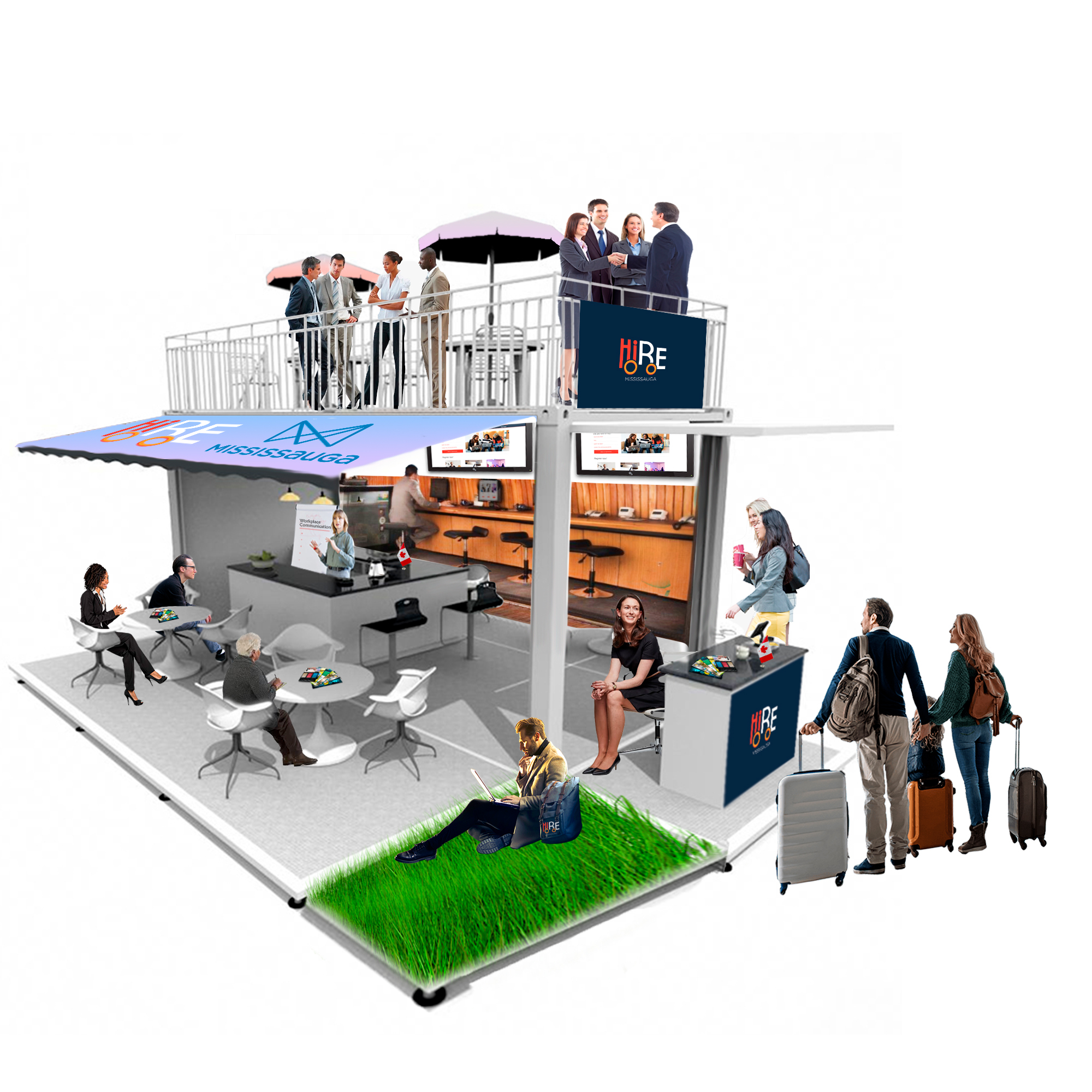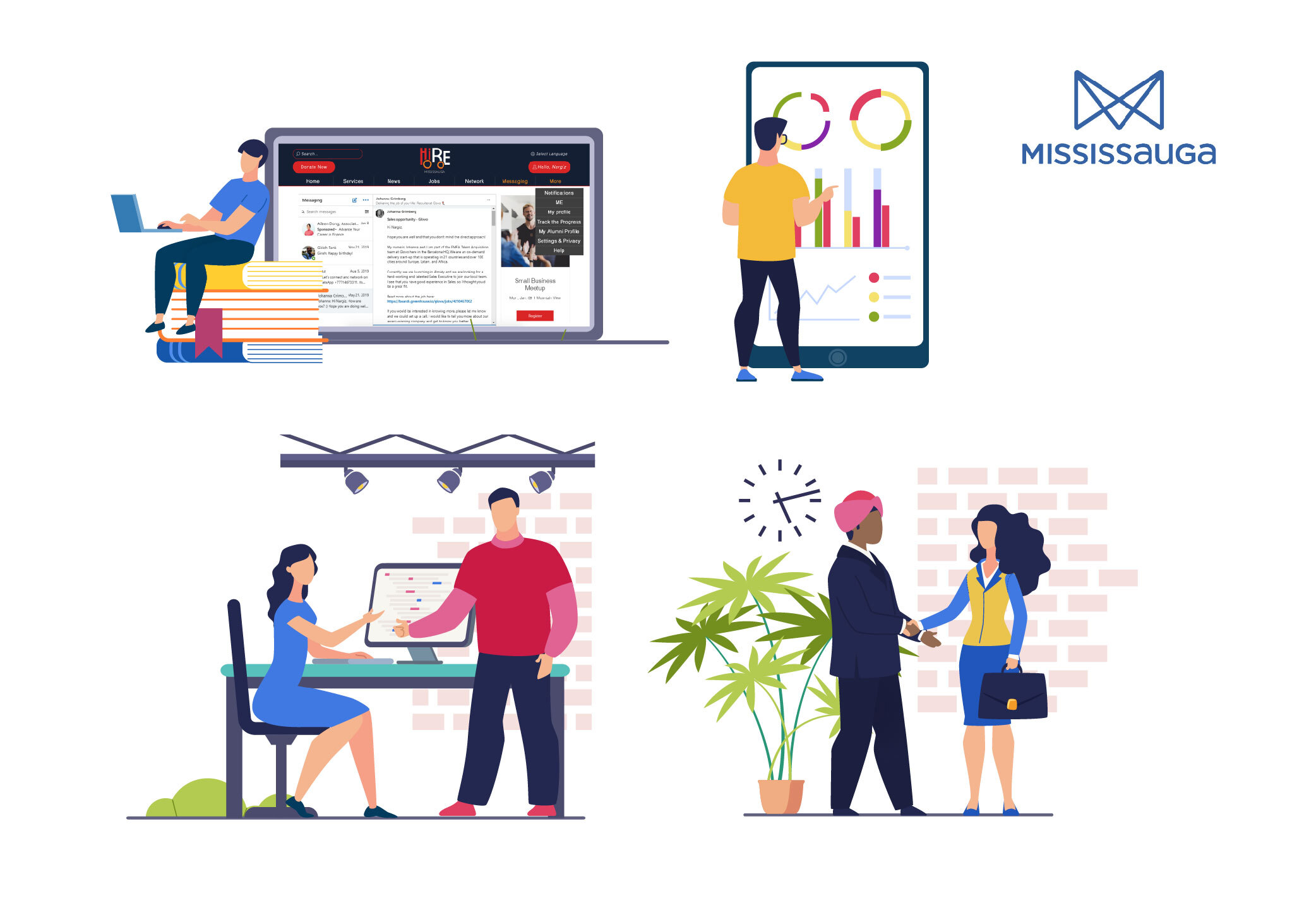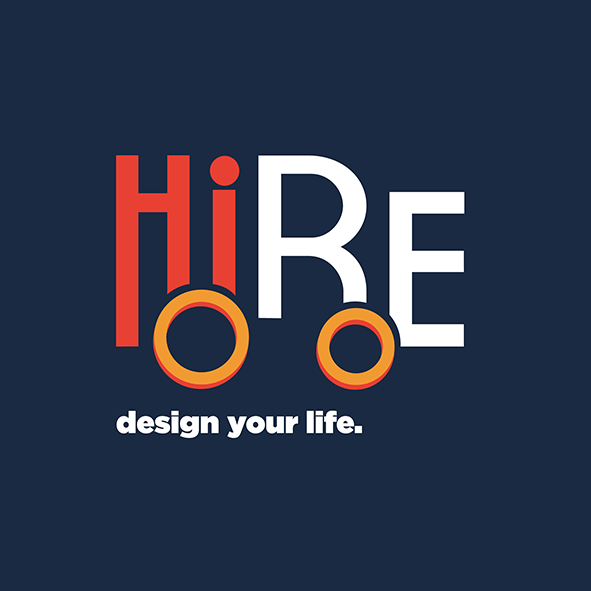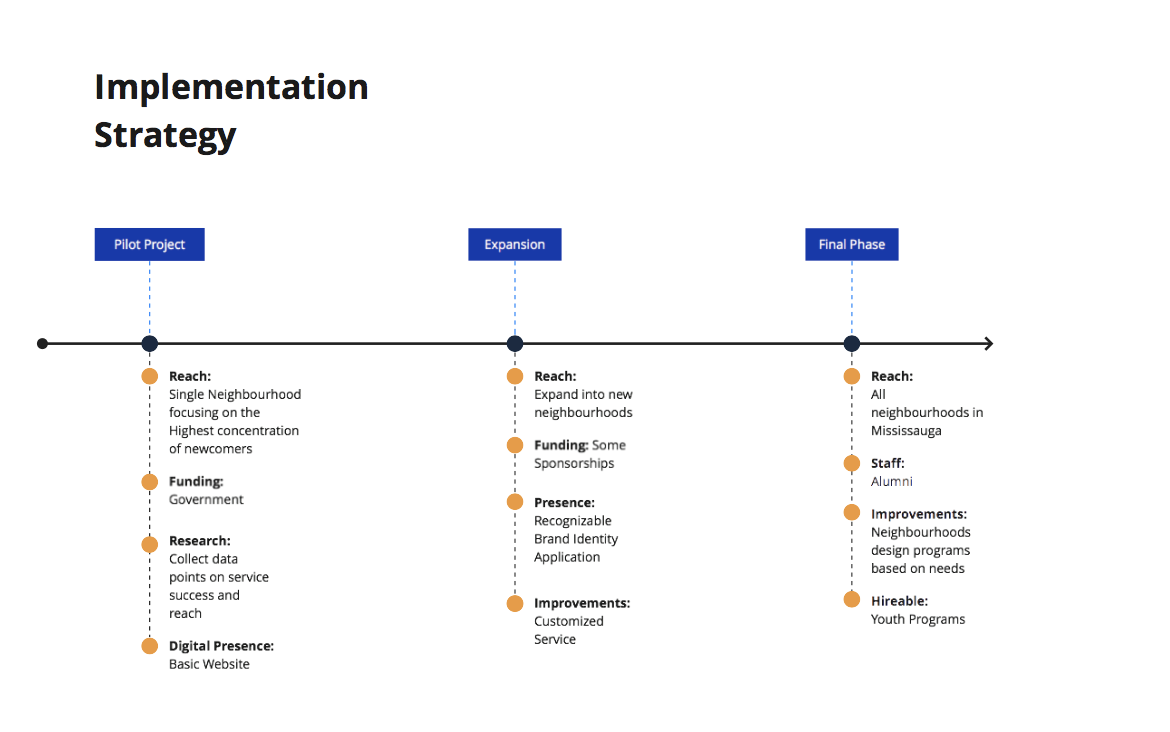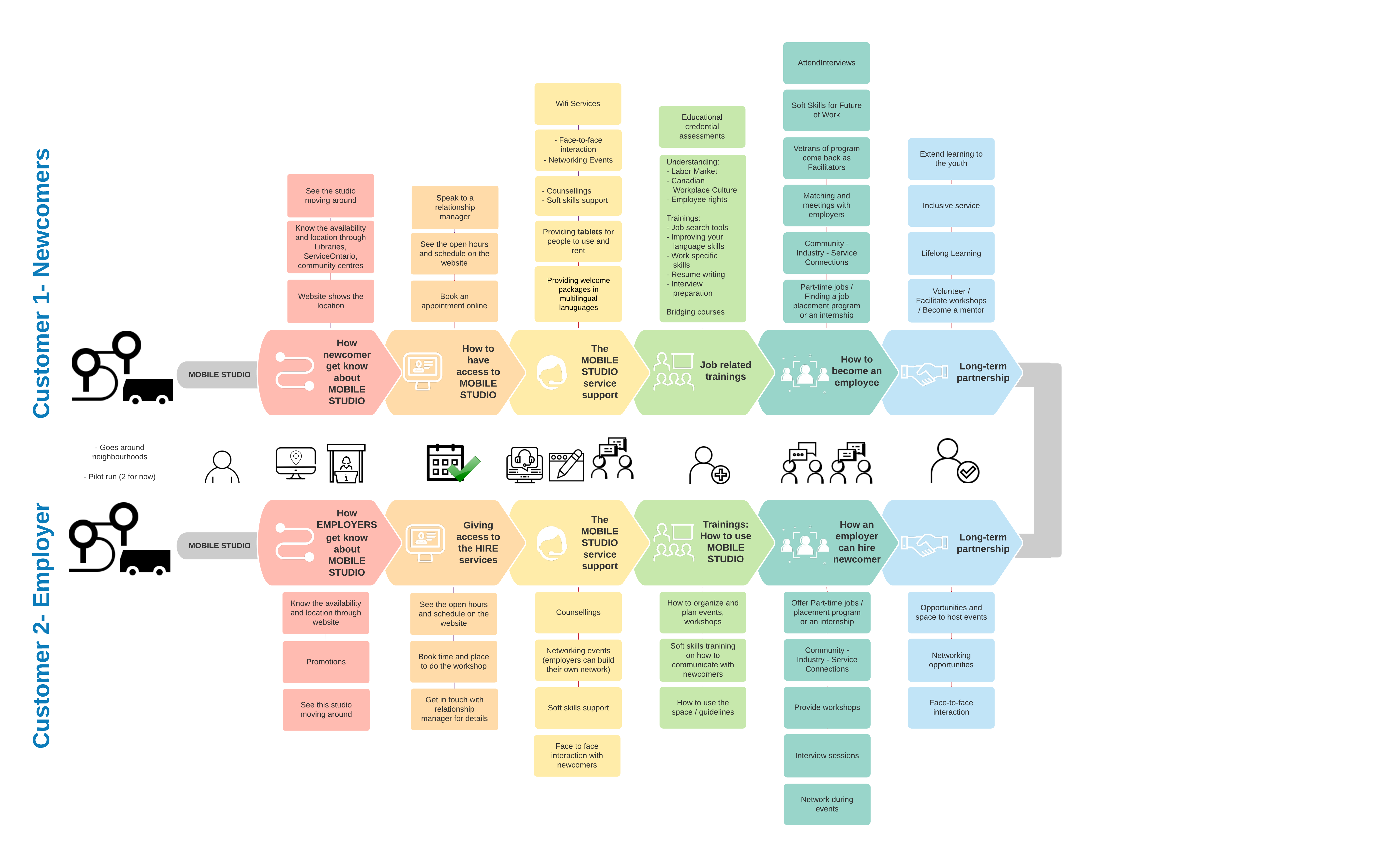Project Description
About the City of Mississauga
Mississauga is the 6th largest city in Canada and is home to over 700,000 people. Since becoming a city in 1974, Mississauga has grown to be one of Canada’s most diverse cities. With its bustling industries in technology and life sciences, and a thriving education scene, Mississauga is generally regarded as abounding with opportunities.
Newcomers and Employment in Mississauga
The City of Mississauga has a diverse population and is home to 240 cultural groups. Between 2011 and 2016, Mississauga welcomed more than 50,000 newcomers, including recent immigrants and refugees. Newcomers often face hurdles when they arrive in new places. Although Mississauga has a digital infrastructure, it must ensure that the newcomer population has access to opportunities that prepare them for the changing nature of work by equipping them with the skills they need to succeed in a digital society.
IwB Design Proposals
Students in the 2019-2020 IwB cohort expanded on the City of Mississauga’s Smart Cities proposal for the International and Production Charrette using the ESC Framework. An adjusted vision, mission and project scope were created for the design proposals.
Vision: To leverage new and existing digital infrastructure to provide equal and accessible opportunities for newcomers to learn the skills needed for the future of work.
Mission: To create a community driven, inclusive and accessible program in Mississauga that will prepare newcomers for the future of work through access to resources, mentorship, skills training, and networking opportunities.
Proposed Site/Project Scope: This design proposal will focus on one neighbourhood in the pilot project before being scaled up to the City of Mississauga.
Solution
HiRE is an inclusive and accessible service that provides person to person connection through soft skills training, guidance, and lifelong learning. This solution consists of two components, a mobile studio and a digital platform.
Mobile Studio
The HiRE mobile studio will go around neighbourhoods in Mississauga offering newcomers employment services that facilitate opportunities for long-term employment. The studio considers the challenges newcomers face and travels to them, thus increasing the accessibility and approachability of the service. HiRE comes equipped with welcome packages in different languages to warmly greet newcomers acknowledging unique cultures and backgrounds. In the backend, the mobile studio is supported by the digital platform where newcomers can connect with employers.
Digital Interface Platform
The Hire digital platform is where industry, community and government can connect and address employment challenges in the city. It is through this platform that caseworkers can facilitate the match between employer needs and newcomer skills. It hosts services like consultation on skills assessment and training plan development, as well as mentorship and industry hosted workshops. The service aims to provide the resources necessary to up-skill and gain relevant work experience.
Process
This section will show how the ESC Framework was tested using Mississauga’s Design Proposal. It showcases how the goals of each step of the framework was met by HiRE establishing it as an Ethical Smart City solution to address the needs of the community.
1. KNOW
What is your definition of an Ethical Smart City?
An Ethical Smart City is one with engagement possibilities for everybody that supports technological advancements, as well as change management and ensures economic resilience and inclusive services through collaboration and open participation.
2. PERSONALIZE
What are the needs of your community (including the right challenge to address, the prioritized values of the community and the appropriate technology to address it)?
Challenges
- Newcomers have a hard time acquiring long-term employment that’s relevant for the future of work.
- Newcomers are not eligible to apply for jobs that match their skills because they lack Canadian work experience.
- More than unemployment for newcomers, there is also a need to address underemployment.
Values
- Inclusion: In a Smart City like Mississauga, inclusion means that newcomers feel like they are part of the community. Personalizing their experiences with existing services will help create community and a more welcoming environment.
- Equity: Providing services that will benefit vulnerable populations and provide equal opportunities for all in the city.
- Accessibility: Ensuring that relevant information and services are offered in different languages in-person and online.
Technology
- Mississauga is already a smart city with existing technological infrastructure.
- IoT: IoT is enabled through a strong network and Wi-Fi network, which allows the City of Mississauga to maintain a strong economic infrastructure.
3. STRATEGIZE
What are the community goals that the solution to the challenge should embody?
- To integrate and leverage existing City of Mississauga digital infrastructure to make relevant information easier to find.
- To create a service that can be used and accessed online and in-person.
- To provide access and support by expanding the employment services to reach as many newcomers and increasing program awareness.
- To provide training and employment to prepare potential employees for desired jobs through required skills training.
- To retain and sustain the jobs of newcomers for long-term and achieve retention through up-skilling the future generation.
4. DESIGN
What is the design solution to address the challenge and how does it uphold the ethical values?
HiRE is a service that consists of two components.
- The mobile studio includes digital and non-digital infrastructure. The studio allows newcomers to meet with employees, build relevant skills for in-demand jobs, and connect with other newcomers in their community. The mobile studio is modular and goes into different neighbourhoods across the City of Mississauga. Additionally, the mobile studio leverages existing newcomer services, from industry professionals to business development services, to help newcomers adjust to life in Mississauga and prepare them for employment.
- The digital interface platform helps connect newcomers to skills training and building opportunities. It fosters lifelong learning and helps build digital literary skills needed for today and the future of work.
5. ADAPT
What is the implementation plan of the solution?
The Implementation Plan has three components. The pilot, the expansion, and the final phase.
The pilot project of HiRE is backed by $50 million and will launch the digital platform and deploy the mobile studio to one neighbourhood that is the most populated by newcomers in the City of Mississauga.This will test the capability of the mobile studio. The information and insights gathered from this initial phase can inform how to improve services for future releases.
In the next phase, HiRE will expand to multiple neighbourhoods across the city of Mississauga, while seeking other sources of funding to support this expansion. Areas of opportunities in this phase will be customizing the services available on the digital platform to help meet the needs of newcomers.
In the final phase, HiRE will extend the services of the mobile studio to all neighbourhoods across the City of Mississauga in order to reach more newcomers. The service will diversify its offerings by looking at ways to add additional programming for specific communities within the newcomer population. It will also add offerings such as youth programs and allow communities to customize the service to fit their needs. This phase of HiRE will continue to leverage existing digital infrastructure while also creating partnerships with existing community services.
